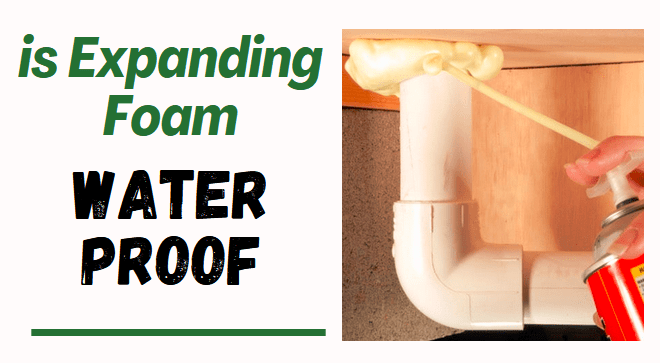Expanding foam, which includes spray foam insulation, open-cell spray foam, and closed-cell spray foam insulation, is widely used for its versatility in insulating wall cavities and sealing gaps and cracks in various surfaces.
Notably, some types of this foam are paintable, stainable, and sandable, offering additional finishing options for various projects. Its high expansion properties make it ideal for filling even the most challenging spaces.
However, a common question arises: is this type of foam waterproof?
The short answer is yes, expanding foam can be waterproof, but the long answer requires more explanation. With that in mind, let’s learn more about waterproof expanding foam in this article.
Is Expanding Foam Waterproof?
As mentioned above, some expanding foam products, especially high-quality closed-cell spray foam insulation, are waterproof or water-resistant. This type of spray foam insulation, known for its high expansion and tack-free properties, is particularly effective in water-exposed areas, such as around rim joists or open wall spaces.
Its ability to resist water absorption and maintain its structure and effectiveness makes it a reliable choice for various applications.
This is because expanding foam is usually made of polyurethane and is meant to fill gaps or voids in a surface. Furthermore, waterproof expanding foams typically have a closed-cell structure that prevents water from entering the foam.

The foam, particularly when applied as high-expansion closed-cell spray foam insulation, will expand, harden, and create a waterproof seal.
This seal, which becomes tack-free after curing, is crucial in preventing water seepage in areas like wall cavities and rim joists, ensuring the integrity of the insulation. Additionally, the foam’s paintable, stainable, and sandable nature allows for aesthetic customization after application.
Once it sets, the hardened foam becomes moisture-resistant and can endure water exposure without losing its shape or effectiveness.
However, the water resistance performance of expanding foam, including various types of spray foam insulation, may vary based on the product and its intended use.
While some expanding foams, particularly those of high quality, have high water resistance and are paintable, stainable, and sandable, others may only offer moderate resistance to water absorption. The tack-free nature of these foams also contributes to their effectiveness in various applications.
What Is The Best Waterproof Expanding Foam?
When selecting waterproof expanding foam, there are many choices to consider. The choice depends on the application and requirements. Consider popular foam options like polyurethane, silicone, or epoxy-based foams.
These water-resistant materials can expand, making them versatile for various applications. However, for waterproof expanding foam products, a few products stand out above the rest. Here are the top choices for specific needs and applications:
● Red Devil Spray Foam
Red Devil’s Spray Foam is an excellent choice to fill large cracks and gaps. This polyurethane-based foam expands to fill spaces up to three times its original size. It provides a smooth, watertight seal that can even be painted over.
● TotalPond Insulating Foam Sealant
TotalPond Insulating Foam Sealant is ideal for outdoor water features such as fountains and ponds. This black foam can expand up to three times its original size and fully cures within 14-24 hours.
● DAP Touch ‘n Foam Warp Window & Door Sealant
DAP Touch ‘n Foam Warp Window & Door Sealant can be an option for sealing windows and doors. It is designed to be water-resistant remains watertight after curing, and can fill gaps and cracks without harming surrounding frames or molding.
● Great Stuff Pond And Stone Insulating Foam Sealant
Finally, for those who need a foam that is safe for fish and plants in a pond or water feature, Great Stuff Pond & Stone is an excellent choice. This ready-to-use, closed-cell polyurethane foam sticks to porous and non-porous rocks without mortar, making a water-resistant outer layer.
How to Use Expanding Foam for Roof Leaks
Overall, expanding foam can be an excellent option for sealing and insulating areas exposed to water. Just be sure to choose a product designed for wet environments.
Read also: Can You Spray Foam Insulation Yourself?
So, if you have a leaky roof, waterproof expanding foam can be a great solution to fix the problem. Here’s how to use it:
- Use a clean cloth, sponge, or appropriate drying material to dry the surface as much as possible. This will get rid of extra water and improve stickiness.
- It’s alright if the surface is damp because expanding foam can stick to slightly damp surfaces. Don’t use foam on surfaces that are too wet or submerged in water because it won’t work well.
- Use the expanding foam sealant to cover the target area completely. The foam will expand, fill gaps, and provide insulation.
- To speed up the healing process and help it expand, dampen the foam slightly with water. Be careful with this step to avoid putting too much foam, making it less effective.
Read also: Is Closed Cell Foam Waterproof?
So, is expanding foam waterproof? Yes, it is. Following this guideline, you can use confident expanding foam according to your needs. However, follow the manufacturer’s instructions carefully for the best results.


